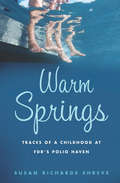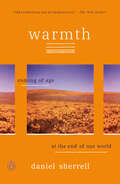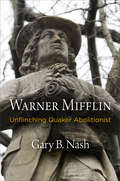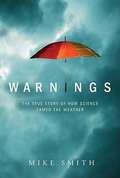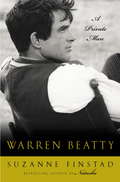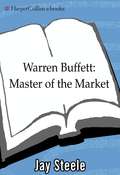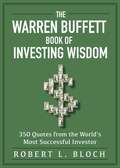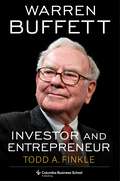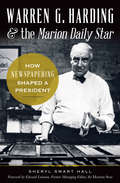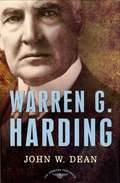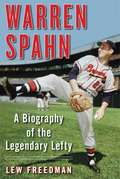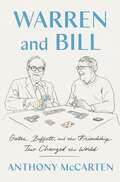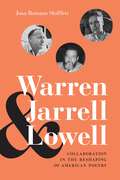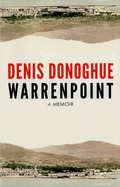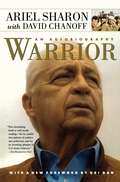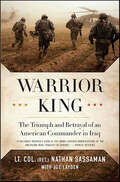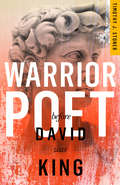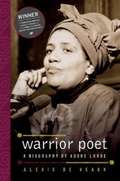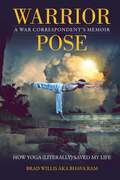- Table View
- List View
Warm Springs: Traces of a Childhood at FDR's Polio Haven
by Susan Richards ShreveJust after her eleventh birthday, Susan Richards Shreve was sent to the sanitarium at Warm Springs, Georgia. The polio haven, famously founded by FDR, was "a perfect setting in time and place and strangeness for a hospital of crippled children." During Shreve's two year stay, the Salk vaccine would be discovered, ensuring that she would be among the last Americans to have suffered childhood polio. At Warm Springs, Shreve found herself in a community of similarly afflicted children, and for the first time she was one of the gang. Away from her fiercely protective mother, she became a feisty troublemaker and an outspoken ringleader. Shreve experienced first love with a thirteen-year-old boy in a wheelchair. She navigated rocky friendships, religious questions, and family tensions, and encountered healing of all kinds. Shreve's memoir is both a fascinating historical record of that time and an intensely felt story of childhood.
Warming Up Julia Child: The Remarkable Figures Who Shaped a Legend
by Helen Lefkowitz HorowitzA Pulitzer prize-finalist peels back the curtain on an unexplored part of Julia Child's life—the formidable team of six she collaborated with to shape her legendary career.
Warmth: Coming of Age at the End of Our World
by Daniel SherrellFrom a millennial climate activist, an exploration of how young people live in the shadow of catastrophe&“Strikingly perceptive.&” —Jenny Offill, author of Weather &“Beautifully rendered and bracingly honest.&” —Jenny Odell, author of How to Do NothingWarmth is a new kind of book about climate change: not what it is or how we solve it, but how it feels to imagine a future--and a family--under its weight. In a fiercely personal account written from inside the climate movement, Sherrell lays bare how the crisis is transforming our relationships to time, to hope, and to each other. At once a memoir, a love letter, and an electric work of criticism, Warmth goes to the heart of the defining question of our time: how do we go on in a world that may not?
Warner Bros.: 100 Years of Storytelling
by Mark A. VieiraIn this official centennial history of the greatest studio in Hollywood, unforgettable stars, untold stories, and rare images from the Warner Bros. vault bring a century of entertainment to vivid life.The history of Warner Bros. is not just the tale of a legendary film studio and its stars, but of classic Hollywood itself, as well as a portrait of America in the last century. It&’s a family story of Polish-Jewish immigrants—the brothers Warner—who took advantage of new opportunities in the burgeoning film industry at a time when four mavericks could invent ways of operating, of warding off government regulation, and of keeping audiences coming back for more during some of the nation's darkest days. Innovation was key to their early success. Four years after its founding, the studio revolutionized moviemaking by introducing sound in The Jazz Singer (1927). Stars and stories gave Warner Bros. its distinct identity as the studio where tough guys like Humphrey Bogart and strong women like Bette Davis kept people on the edge of their seats. Over the years, these acclaimed actors and countless others made magic on WB&’s soundstages and were responsible for such diverse classics as Casablanca, A Streetcar Named Desire, A Star Is Born, Bonnie & Clyde, Malcolm X, Caddyshack, Purple Rain, and hundreds more. It&’s the studio that put noir in film with The Maltese Falcon and other classics of the genre, where the iconic Looney Tunes were unleashed on animation, and the studio that took an unpopular stance at the start of World War II by producing anti-Nazi films. Counter-culture hits like A Clockwork Orange and The Exorcist carried the studio through the 1970s and '80s. Franchise phenomena like Harry Potter, the DC universe, and more continue to shape a cinematic vision and longevity that is unparalleled in the annals of film history. These stories and more are chronicled in this comprehensive and stunning volume. Copyright © 2023 Warner Bros. Entertainment Inc.
Warner Bros: The Making of an American Movie Studio
by David ThomsonBehind the scenes at the legendary Warner Brothers film studio, where four immigrant brothers transformed themselves into the moguls and masters of American fantasyWarner Bros charts the rise of an unpromising film studio from its shaky beginnings in the early twentieth century through its ascent to the pinnacle of Hollywood influence and popularity. The Warner Brothers—Harry, Albert, Sam, and Jack—arrived in America as unschooled Jewish immigrants, yet they founded a studio that became the smartest, toughest, and most radical in all of Hollywood. David Thomson provides fascinating and original interpretations of Warner Brothers pictures from the pioneering talkie The Jazz Singer through black-and-white musicals, gangster movies, and such dramatic romances as Casablanca, East of Eden, and Bonnie and Clyde. He recounts the storied exploits of the studio’s larger-than-life stars, among them Al Jolson, James Cagney, Bette Davis, Errol Flynn, Humphrey Bogart, James Dean, Doris Day, and Bugs Bunny. The Warner brothers’ cultural impact was so profound, Thomson writes, that their studio became “one of the enterprises that helped us see there might be an American dream out there.”
Warner Mifflin: Unflinching Quaker Abolitionist
by Gary B. NashWarner Mifflin—energetic, uncompromising, and reviled—was the key figure connecting the abolitionist movements before and after the American Revolution. A descendant of one of the pioneering families of William Penn's "Holy Experiment," Mifflin upheld the Quaker pacifist doctrine, carrying the peace testimony to Generals Howe and Washington across the blood-soaked Germantown battlefield and traveling several thousand miles by horse up and down the Atlantic seaboard to stiffen the spines of the beleaguered Quakers, harried and exiled for their neutrality during the war for independence. Mifflin was also a pioneer of slave reparations, championing the radical idea that after their liberation, Africans in America were entitled to cash payments and land or shared crop arrangements. Preaching "restitution," Mifflin led the way in making Kent County, Delaware, a center of reparationist doctrine.After the war, Mifflin became the premier legislative lobbyist of his generation, introducing methods of reaching state and national legislators to promote antislavery action. Detesting his repeated exercise of the right of petition and hating his argument that an all-seeing and affronted God would punish Americans for "national sins," many Southerners believed Mifflin was the most dangerous man in America—"a meddling fanatic" who stirred the embers of sectionalism after the ratification of the Constitution of 1787. Yet he inspired those who believed that the United States had betrayed its founding principles of natural and inalienable rights by allowing the cancer of slavery and the dispossession of Indian lands to continue in the 1790s.Writing in beautiful prose and marshaling fascinating evidence, Gary B. Nash constructs a convincing case that Mifflin belongs in the Quaker antislavery pantheon with William Southeby, Benjamin Lay, John Woolman, and Anthony Benezet.
Warnings: The True Story of how Science tamed the Weather
by Mike SmithExperience the most devastating storms of the last fifty years through the eyes of the scientific visionaries who took them on and tamed them. Science and politics collide in this thrilling account of America's struggle for protection against the deadly threat of violent weather. Warnings tells the dramatic true stories of the unsung weather warriors who save innocent lives, often by risking their own.
Warren Beatty: A Private Man
by Suzanne Finstad"Whatever you have read or heard about me through articles or gossip, forget it. I am nothing like that Warren Beatty. I am nothing like what you have read." --Warren Beatty. Warren Beatty guarded his privacy even before he became a movie star, when he burst onto the screen in 1961 as the earnestly handsome all-American boy in Splendor in the Grass. When he started acting, Beatty kept secret the fact that actress Shirley MacLaine, already a star, was his older sister. Over time, he has cultivated a mystique, giving few interviews and instructing others not to talk about him. Until now. Through years of groundbreaking research, lauded biographer Suzanne Finstad gained unprecedented access to Beatty's family, close friends, and film colleagues, including such luminaries in the arts and politics as Jane Fonda, Goldie Hawn, Leslie Caron, Robert Towne, Mike Nichols, and Senators John McCain, George McGovern, and Gary Hart. Weaving hundreds of these candid interviews, photographs from private albums, personal letters, diaries, and the previously unpublished papers of the late Natalie Wood and mentors such as directors Elia Kazan and George Stevens, playwrights Clifford Odets and William Inge, and agent Charles Feldman, Warren Beatty unveils the real Beatty--a complex, sensitive visionary torn between the "fairly puritanical, football-playing boy" from Virginia and his Hollywood playboy image. Finstad paints a rich, fascinating portrait of the secretive film legend, taking us back to the "unrealized genius" parents who molded arguably the most famous brother and sister in Hollywood history, tracing the family influences and events in Beatty's past that directly inspired McCabe & Mrs. Miller, Shampoo, Heaven Can Wait, Reds, Ishtar, Dick Tracy, Bugsy, Love Affair, and Bulworth, and led to his political activism, culminating in a near-bid for the White House. Finstad constructs the definitive, myth-shattering account of Beatty's evolution from Hollywood's enfant terrible to producer of the revolutionary Bonnie and Clyde, launching him as the premier actor/director/writer/producer of his generation, the only person to twice earn Oscar nominations in all five major categories. Here also is the truth about Beatty the lover, setting the record straight on his storied relationships with such iconic actresses and beauties as Jane Fonda, Joan Collins, Natalie Wood, Leslie Caron, Julie Christie, Goldie Hawn, Michelle Phillips, Diane Keaton, Isabelle Adjani, and Madonna. Finstad's astute insights illuminate Beatty's private struggle to attain happiness, his complicated bond with his sister, Shirley, and the deeper reasons why, at fifty-four, the archetypal bachelor married actress Annette Bening. Stunningly researched, engrossing, and exquisitely detailed, Warren Beatty: A Private Man gives us a new understanding of the enigmatic, fiercely intelligent star who embodies the American dream.
Warren Buffett
by Jay SteeleWarren Buffett is known as the billionaire investment expert of the century and everyone would love to know the secret of his success. In his own words, Buffett is just a regular guy who likes fast food, honest work, and people he can trust. Throw in incredible instincts, a genius for numbers, meticulous research, and an almost sure-fire investment philosophy, and you begin to understand how he's become a legend in his own time. With just a few thousands of dollars from relatives and friends, and by taking calculated risks with small companies and staying with them, he managed, almost single-handedly, to turn Salomon Brothers around. Giants like Disney, American Express, McDonald's, Gillette, and Coca-Cola have all been affected by Buffett's magic touch, and he owns a chunk of all of them. By thirty-one, BUffett had already made himself a millionaire, and he's worked his way steadily toward the top of the Forbes list. Here is a fascinating portrait of Warren Buffett, known for his investigating genius, his sense of humor, and his mean turn of a phrase. It's an amazing story of a man who carved his own path through American business by doing his homework, backing companies he believed in, and growing rich on their success-a story that will show you that opportunity abounds for anyone willing to go for it.
Warren Buffett Book of Investing Wisdom: 350 Quotes from the World's Most Successful Investor
by Robert L. BlochCompiled by the son of the cofounder of H&R Block, a collection of business quotes and advice from the most successful investor of the twentieth century, Warren Buffett. Warren Buffett, chairman and CEO of Berkshire Hathaway, is widely considered the most successful investor of the twentieth century. Since the early 1950s, Buffett has proved himself to be an astute investor, and he turned Berkshire Hathaway from a struggling small textile business into the tenth-largest public company in the world, valued at more than $600 billion. Buffett is well known for his simple but invaluable principles regarding investing and finances, and countless businessmen and people looking to be smarter with their money and their investments have turned to Buffett for his advice. One of those people is Robert Bloch, son of the cofounder of the tax preparation company H&R Block.The Warren Buffett Book of Investing Wisdom contains 350 quotes that Bloch has personally found to be indispensable to financial success. With the written blessing of Buffett himself, Bloch has selected the best of Buffett, wisdom that will guide you to becoming the most disciplined and rational long-term investor you can be.
Warren Buffett: Investor and Entrepreneur
by Todd A. FinkleWarren Buffett is perhaps the most accomplished investor of all time. The CEO and chair of Berkshire Hathaway has earned admiration for not only his financial feats but also the philosophy behind them. Todd A. Finkle provides striking new insights into Buffett’s career through the lens of entrepreneurship. This book demonstrates that although Buffett is thought of primarily as an investor, one of the secrets to his success has been running Berkshire as an entrepreneur.Finkle—a Buffett family friend—shares his perspective on Buffett’s early life and business ventures. The book traces the entrepreneurial paths that shaped Buffett’s career, from selling gum door-to-door during childhood to forming Berkshire Hathaway and developing it into a global conglomerate through the imaginative deployment of financial instruments and creative deal making. Finkle considers Buffett’s investment methodology, management strategy, and personal philosophy on building a rewarding life in terms of entrepreneurship. He also zeros in on Buffett’s longtime business partner, Charlie Munger, and his contributions to Berkshire’s success. Finkle draws key lessons from Buffett’s mistakes as well as his successes, using these failures to explore the ways behavioral biases can affect investors and how to overcome them.By viewing Buffett as an entrepreneur, this book offers readers a fresh take on one of the world’s best-known financial titans.
Warren G. Harding & the Marion Daily Star: How Newspapering Shaped a President
by Sheryl Smart HallHow a committed journalist transformed a small town daily newspaper—and how that editorial success inspired his policies as President of the United States. President Warren G. Harding&’s thirty-nine-year career as a newspaperman is often treated as a footnote. This book offers a unique approach to the Harding story, presenting him as he saw himself: as a newspaperman. His political successes were based on the thinking of a newspaper editor—balancing all of the facets of an issue, examining the facts and weighing the effect on the constituents. Even his approach to balancing the federal budget was built on early experience at his small, struggling newspaper, where his motto was: &“All paid in, all paid out, books even.&” The only member of the Fourth Estate to enter the White House, Harding found his voice through the pages of the Marion Daily Star. Author Sheryl Smart Hall offers an intimate view of the man, often as seen through the eyes of those who knew him best—his co-workers at the Star. Includes photos
Warren G. Harding (The American Presidents Series)
by John W. Dean Arthur M. SchlesingerWarren G. Harding may be best known as America's worst president. Scandals plagued him: the Teapot Dome affair, corruption in the Veterans Bureau and the Justice Department, and the posthumous revelation of an extramarital affair.
Warren G. Harding: Twenty-ninth President of the United States
by Anne CanadeoPresents the life of Warren G. Harding, including his childhood, education, employment, and political career.
Warren Spahn: A Biography of the Legendary Lefty
by Lew FreedmanWith 363 victories, Warren Spahn is the winningest left-handed pitcher in baseball history. During his 21-year career, Spahn won 20+ games thirteen times, was a 17-time All Star, a Cy Young–award winner, and was elected to the National Baseball Hall of Fame in 1973. In addition, Spahn was also a war hero, serving in World War II and awarded the Purple Heart.To say Spahn lived a storied life is an understatement.In Warren Spahn, author Lew Freedman tells the story of this incredible lefty. Known for his supremely high leg kick, Spahn became one of the greatest pitchers in baseball history. However, the road wasn’t as easy as it would seem.Struggling in his major-league debut at age twenty, manager Casey Stengel demoted the young left. It would be four years before Spahn would return to the diamond, as he received a calling of a different kind—one from his country.Enlisting in the Army, Spahn would serve with distinction, seeing action in the Battle of the Bulge and the Ludendorff Bridge, and was awarded a battlefield commission, along with a Purple Heart.Upon his return to the game, he would take the league by storm. Spahn dominated for over two decades, spending twenty years with the Braves (both Boston and Milwaukee), as well as a season with the New York Mets and San Francisco Giants. Pitching into his mid-forties, he would throw two no-hitters at the advanced ages of thirty-nine and forty. From his early days in Buffalo and young career, through his time and the military and all the way to the 1948 Braves and “Spahn and Sain and Pray for Rain,” author Lew Freedman leaves no stone unturned in sharing the incredible life of this pitching icon, who is still considered the greatest left-handed pitcher to ever play the game.
Warren and Bill: Gates, Buffett, and the Friendship That Changed the World
by Anthony McCartenFrom the Academy Award-nominated screenwriter of The Theory of Everything, Darkest Hour, and The Two Popes comes the fascinating account of Bill Gates and Warren Buffett’s friendship—one of the most impactful relationships in history, and the basis of an upcoming play and film.Few friendships have had such far-reaching implications for the world—from finance to technology to philanthropy—than that between Bill Gates and Warren Buffett. After meeting at a party in 1991, the two played cards and golf, shared jokes, swapped trade secrets, ate junk food, talked and listened. Their growing friendship would impact each man and lead to change on a grander scale, culminating in the development of the Bill and Melinda Gates Foundation, which holds nearly $50 billion in assets.How did such an unusual union blossom? In what ways specifically did each man begin to influence the other? How did these two avid wealth accumulators jointly decide to address some of the world’s most critical problems—poverty, disease, inequality—by giving their wealth away? And what, finally, does their giga-wealthy partnership mean for the rest of us in an age of great wealth—and great inequality? This book gives the fullest account yet of this extraordinary relationship and explores how it has transformed these two men—and is changing the world for the better for all of us.
Warren, Jarrell, and Lowell: Collaboration in the Reshaping of American Poetry
by Joan Romano ShifflettRobert Penn Warren, Randall Jarrell, and Robert Lowell maintained lifelong, well-documented friendships with one another, often discussing each other’s work in private correspondence and published reviews. Joan Romano Shifflett’s Warren, Jarrell, and Lowell: Collaboration in the Reshaping of American Poetry traces the artistic and personal connections between the three writers. Her study uncovers the significance of their parallel literary development and reevaluates dominant views of how American poetry evolved during the mid-twentieth century. Familiar accounts of literary history, most prominently the celebration of Lowell’s Life Studies as a revolutionary breakthrough into confessional poetry, have obscured the significance of the deep connections that Lowell shared with Warren and Jarrell. They all became quite close in the 1930s, with the content and style of their early poetry revealing the impact of their mentors John Crowe Ransom and Allen Tate, whose aesthetics the three would ultimately modify and transform. The three poets achieved professional maturity and success in the 1940s, during which time they relied on one another’s honest critiques as they experimented with changes in subject matter and modes of expression. Shifflett shows that their works of the late 1940s were heavily influenced by Robert Frost. This period found Warren, Jarrell, and Lowell infusing ostensibly simple verse with multifaceted layers of meaning, capturing the language of speech in diction and rhythm, and striving to raise human experience to a universal level. During the 1950s, the three poets became public figures, producing major works that addressed the nation’s postwar need to reconnect with humanity. Warren, Jarrell, and Lowell continued to respond in interlocking ways throughout the 1960s, with each writer using innovative stylistic techniques to create a colloquy with readers that directed attention away from superficial matters and toward the important work of self-reflection. Drawing from biographical materials and correspondence, along with detailed readings of many poems, Warren, Jarrell, and Lowell offers a compelling new perspective on the shaping of twentieth-century American poetry.
Warrenpoint
by Denis DonoghueWarrenpoint is a memoir, and more than a memoir: with moments of novelistic narrative and lyricism wedded to musings on the aesthetic and theological themes of the author's coming of age--filial piety, original sin, a child's perceptions, and then the nature of terrorism, and of reading itself--it demonstrates the same insight and lucidity that have contributed to Denis Donoghue's fame as one of our most important critics. Taking its title from the seaside town in Northern Ireland whose police barracks served as the residence for the Catholic Donoghues, it has been described as a family romance, dealing not only with the author's love for his strong-willed, taciturn, policeman father, but his love for literature and how it shaped his life to come.
Warrior
by David Chanoff Ariel SharonIsrael's newest prime minister as of February 6, 2001, Ariel Sharon is a dynamic and controversial leader. A hero in Israel's wars, perhaps the most daring and successful commander in Israel's extraordinary military history, Sharon has always been a warrior, whether the enemies were hostile Arab nations, terrorists, Time magazine, or rival politicians. The public man is well known -- aggressive in battle, hard-line in politics -- but the private man has always been obscured by Sharon's dazzling career and powerful personality. In this compelling and dramatic auto-biography, the real Sharon appears for the first time: a complex man, a loving father, a figure of courage and compassion. He is a warrior who commands the respect and love of his troops, a visionary, and an uncompromising, ruthless pragmatist. Sharon tells his story with frankness, power, intelligence, and a brilliant gift for detail. Always controversial, he is as outspoken as his friends -- and enemies -- would expect him to be.
Warrior Girl
by Pauline ChandlerAlthough surrounded by treachery, Mariane, a young mute, battles alongside her cousin, Joan of Arc, for the liberation of France from the English.
Warrior King: The Triumph and Betrayal of an American Commander in Iraq
by Joe Layden Nathan SassamanThe startling and controversial memoir of combat and betrayal, written by one of the most prominent members of the U.S. fighting forces in Iraq.A West Point graduate, a former star quarterback who carried Army to its first bowl victory, and a courageous warrior who had proven himself on the battlefield time and again, Lt. Col. Nathan Sassaman was one of the most celebrated officers in the United States military. He commanded more than eight hundred soldiers in the heart of the insurgency-ravaged Sunni Triangle in Iraq, and his unit's job was to seek out and eliminate terrorists and loyalists to Saddam Hussein, while simultaneously rebuilding the region's infrastructure and introducing democratic processes to a broken people. Sassaman's tactics were highly aggressive, his methods innovative, and his success in Iraq nearly unparalleled.Yet Sassaman will always be known for a fateful decision to cover up the alleged drowning of an Iraqi by his men, in which they purportedly forced two detainees to jump into the Tigris River. The army initially charged three soldiers with manslaughter and a fourth with assault---the first time troops who served in Iraq have been charged with a killing in connection with the handling of detainees. Sassaman's decision led to his downfall, despite an impressive career, and sent shock waves through the American military.This controversial decision goes to the heart of the complex fight in Iraq, where key army leaders betray one another, politics in the war room leads to lost lives on the battlefield, and enemy factions routinely sabotage U.S. efforts, making success difficult for American commanders on the battlefield.Warrior King is the explosive memoir of one of the most deeply involved members of the U.S. military in Iraq. This is the first book to take readers from the overnight brutality of combat to the daunting daytime humanitarian tasks of rebuilding Iraq to the upper echelons of the Pentagon to show how and why the war has gone horribly wrong.
Warrior Mother: A Memoir of Fierce Love, Unbearable Loss, and Rituals that Heal
by Sheila K. CollinsWarrior Mother is the true story of a mother’s fierce love and determination, and her willingness to go outside the bounds of the ordinary when two of her three adult children are diagnosed with life-threatening diseases. When Sheila Collins’s best friend, dying of breast cancer, asked her to accompany her through what turned out to be the last fourteen days of her life, she didn’t know that the experience was preparing her for what lay ahead with her own children. In the years that followed, Collins had to face both her son’s diagnosis with AIDS and her daughter’s diagnosis with breast cancer. Warrior Mother documents how she faces these challenges and the issues accompanying them—from learning to be the mother of a gay son to visiting a healer in Brazil on her daughter’s behalf when she decides on bone marrow transplant treatment. Experience as a professional social worker and family therapist doesn’t always help Collins to cope with her children’s illnesses—but her relationship with improvisational song, dance, storytelling, and women’s spirituality rituals carries her through. Warrior Mother follows Collins’s family through memorials and celebrations of lives well lived, all the while exploring the impact of grief on those left behind and the rituals that help them heal.
Warrior Poet
by Timothy J. StonerWhat happened before David became a notorious lover and conquering king? Meet young David as he struggles with prodigious gifts and crushing weaknesses. Inspired by the Biblical story, Warrior Poet offers a new look the "man after God's own heart." A man whose words in the Psalms continue shape lives and faith today.Feel the crunch of sand under your feet. Hear the roar of enemy armies as this novel sweeps you to ancient Israel. Walk alongside David as he faces his most famous enemy, is captivated by a princess, and hears God's call on his life.Warrior Poet brings this hero of the faith to life. Let his story inspire your own.
Warrior Poet: A Biography of Audre Lorde
by Alexis De VeauxWinner of the 2005 Lambda Literary Award, the Hurston/Wright Legacy Award, and the Gustavus Myers Outstanding Book Award: the first and "essential" (Choice) biography of the author, poet, and American icon of womanhood, black arts, and survival. During her lifetime, Audre Lorde (1934-1992), author of the landmark Cancer Journals, created a mythic identity for herself that retains its vitality to this day. Drawing from the private archives of the poet's estate and numerous interviews, Alexis De Veaux demystifies Lorde's iconic status, charting her conservative childhood in Harlem; her early marriage to a white, gay man with whom she had two children; her emergence as an outspoken black feminist lesbian; and her canonization as a seminal poet of American literature.
Warrior Pose: How Yoga (Literally) Saved My Life
by Brad Willis Bhava RamFrom covering the front lines of the Gulf War to investigating Colombian drug lords to living with freedom fighters in the mountains of Afghanistan, war correspondent Brad Willis was accustomed to risk. But when mortal danger came, it was from an unexpected direction. At the pinnacle of his career, a broken back and failed surgery left Willis permanently disabled and condemned to life in a body brace. Then came a diagnosis of terminal, stage IV throat cancer. At his 50th birthday party, friends gathered around Willis, who was crippled, almost mute, depressed, strung out on narcotic medications, and dying. Halfway through the celebration Willis realized the party's true purpose—his friends were there to say goodbye. Everyone knew Willis was on his way out...everyone except his 2-year-old son, who urged, &“Get up, Daddy!" His son's words ringing in his ears, Willis chose to abandon Western medicine and embrace the most esoteric practices of Yoga to heal his body, mind, and soul—ridding himself of cancer and fully restoring his back. As a symbol of his journey, he took the spiritual name Bhava Ram, which stands for &“Living from the Heart." Warrior Pose is an adventure chronicling some of the most momentous events of our time through a journalist's eyes, an unforgettable story about the power of love between father and son, and a transformational journey of self-healing, inner peace, and wholeness.
